Abstract
Age-related loss of strength contributes to impaired mobility and increases the risk of falls. Recent research has focused on 2 approaches to preventing age-related loss of strength--promoting physical activity and exercise (especially strength training) and using trophic factors to enhance muscle performance. Epidemiologic evidence strongly supports a role of regular physical activity in successful aging by preserving muscle performance, promoting mobility, and reducing fall risk. Randomized controlled trials provide convincing evidence that strength and endurance training improve muscle performance in older adults. Evidence is rapidly accumulating from randomized trials that endurance, strength, and balance training promote mobility and reduce fall risk, though exercise effects differ according to the type of exercise, details of the exercise program, and the target group of older adults. Because lifetime regular physical activity is recommended for all older adults, a reasonable strategy (especially for weak adults) is an activity program that includes strength training. In contrast, insufficient evidence exists to recommend the long-term use of trophic factors to preserve muscular performance. An intervention that merits additional study is avoiding the use of psychoactive drugs because drugs like benzodiazepines appear to be risk factors for inactivity and may have unrecognized direct effects on muscular performance. Because chronic illness is a risk factor for inactivity and disuse muscle atrophy, randomized trials comparing strength training with other interventions would be useful in understanding whether strength training has advantages in preserving muscle performance and improving health-related quality of life in a variety of chronic illnesses such as depressive illness.
Full text
PDF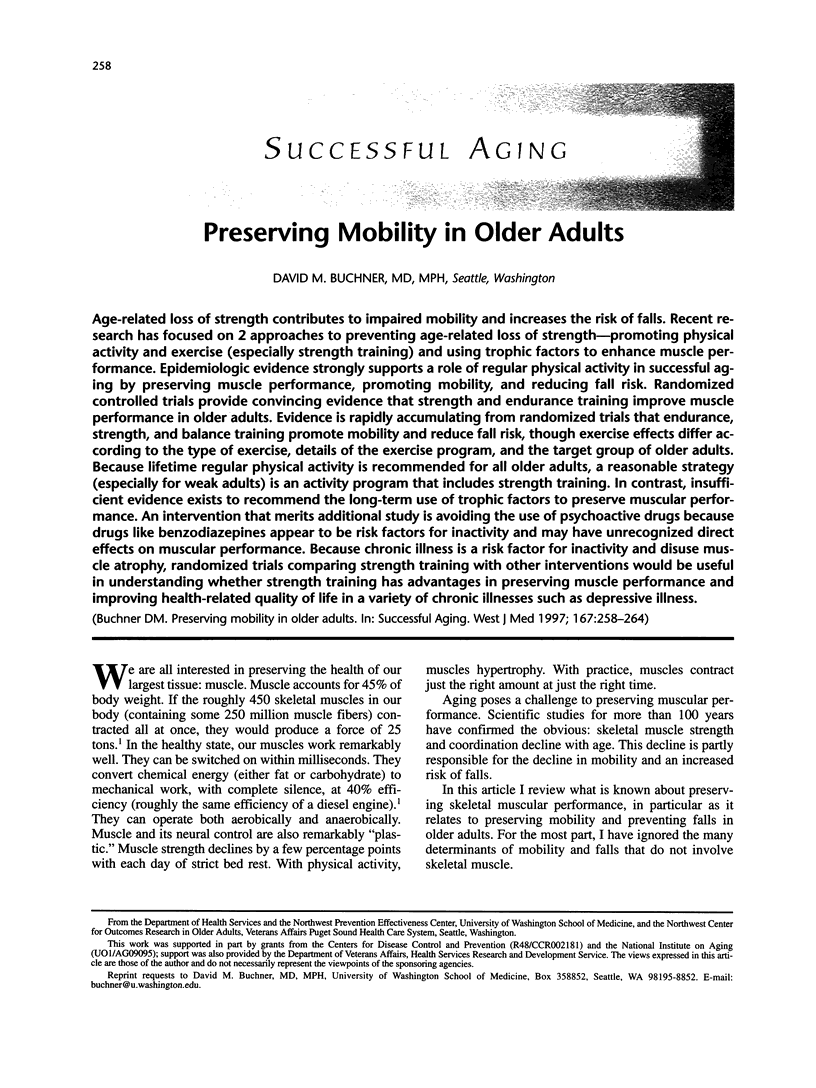
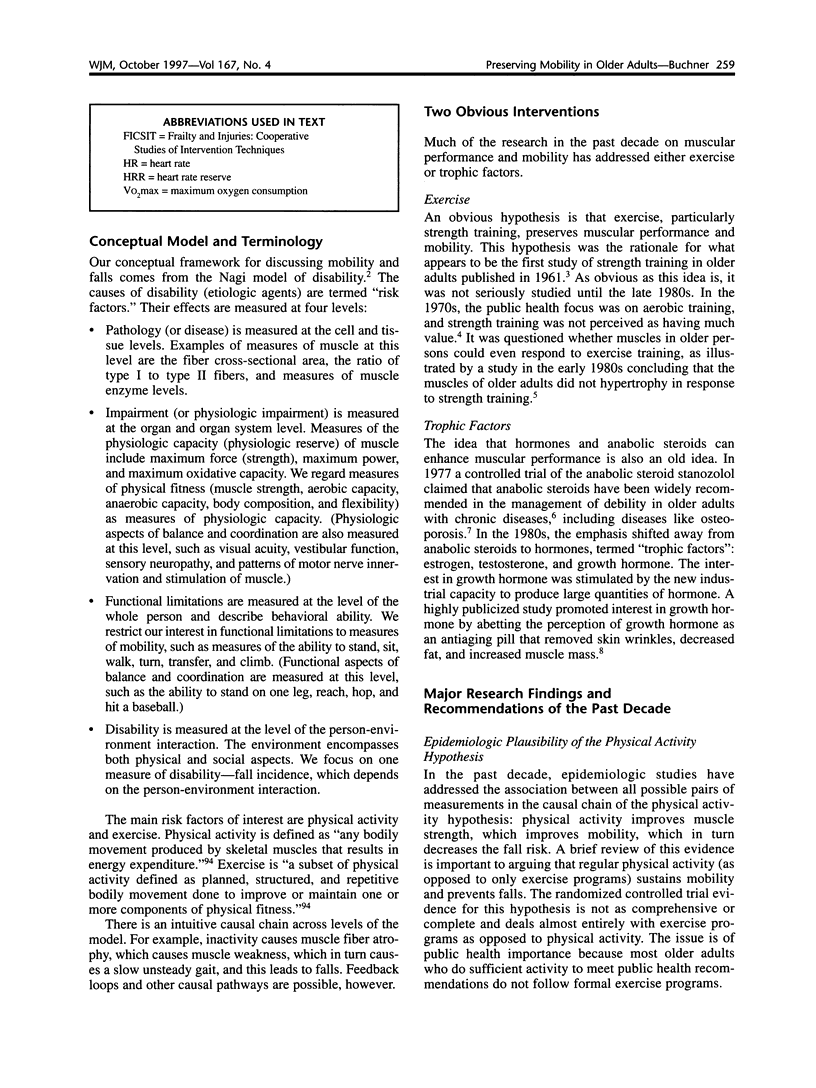
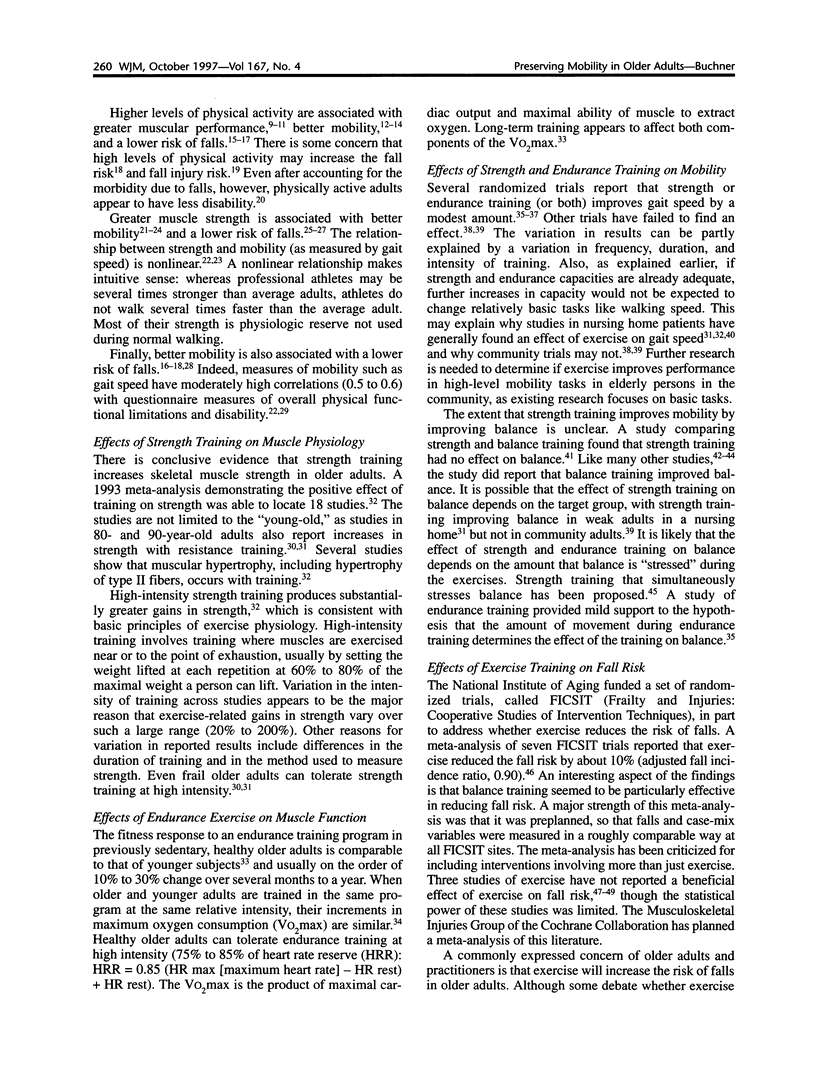
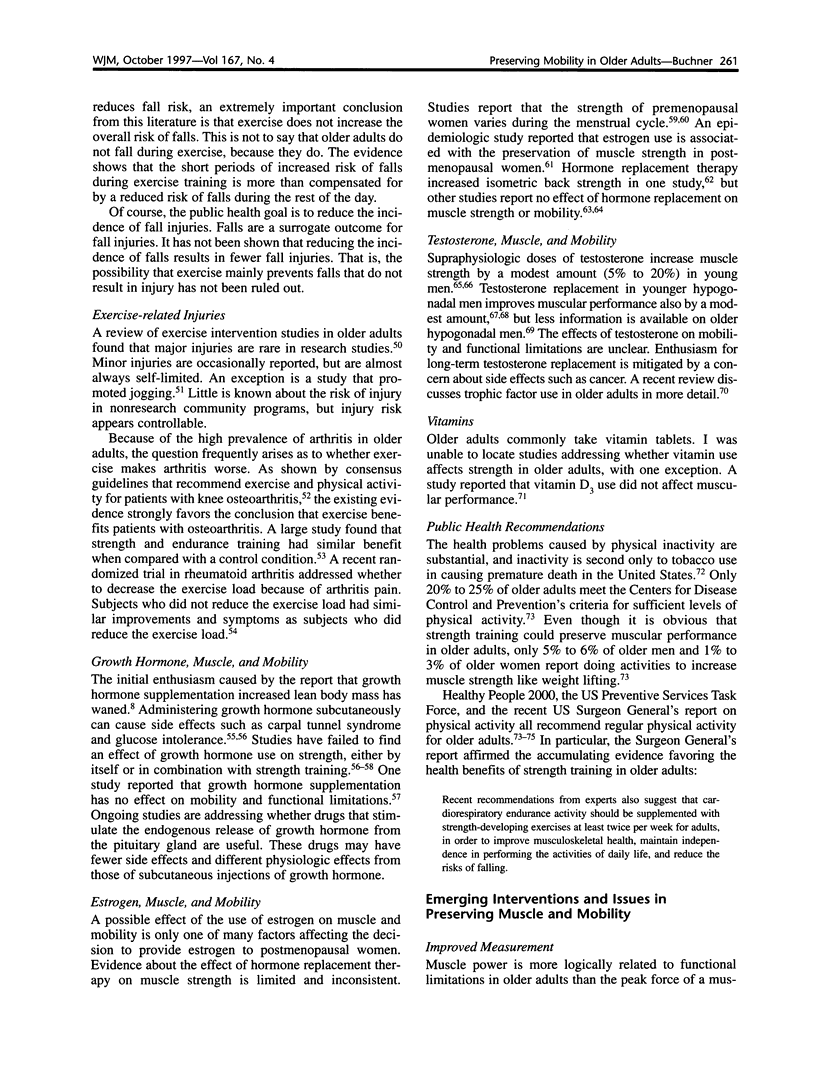
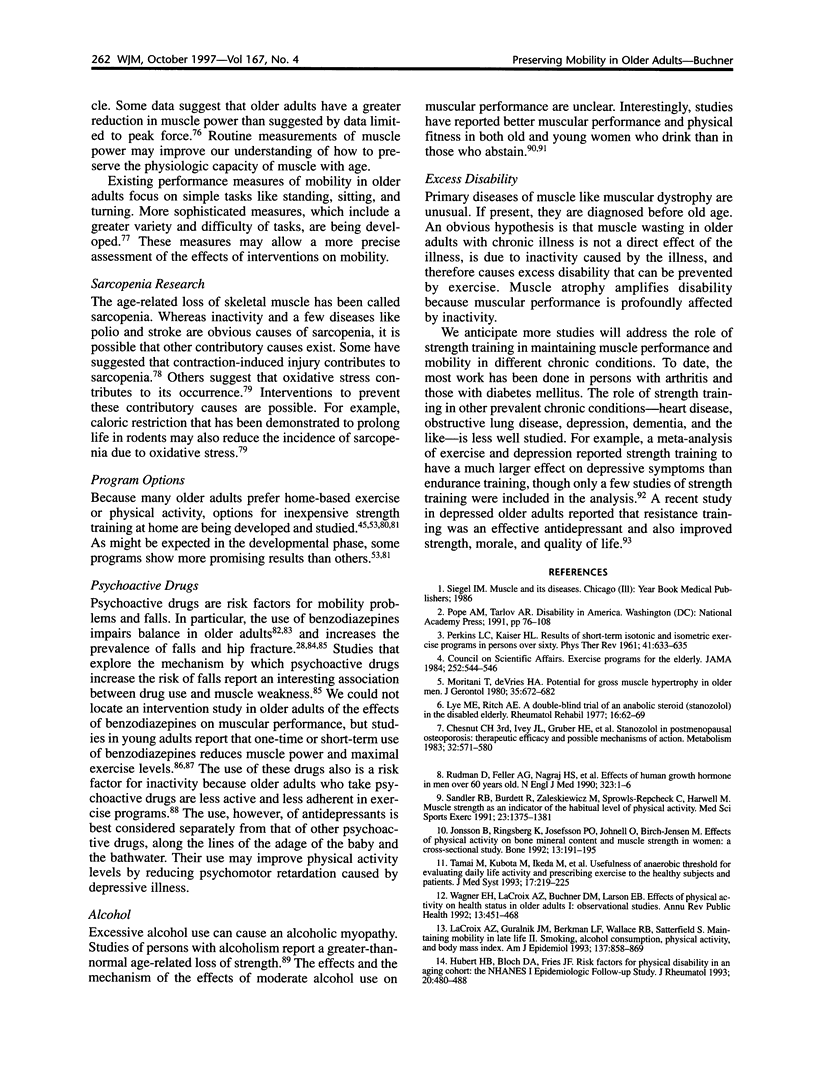
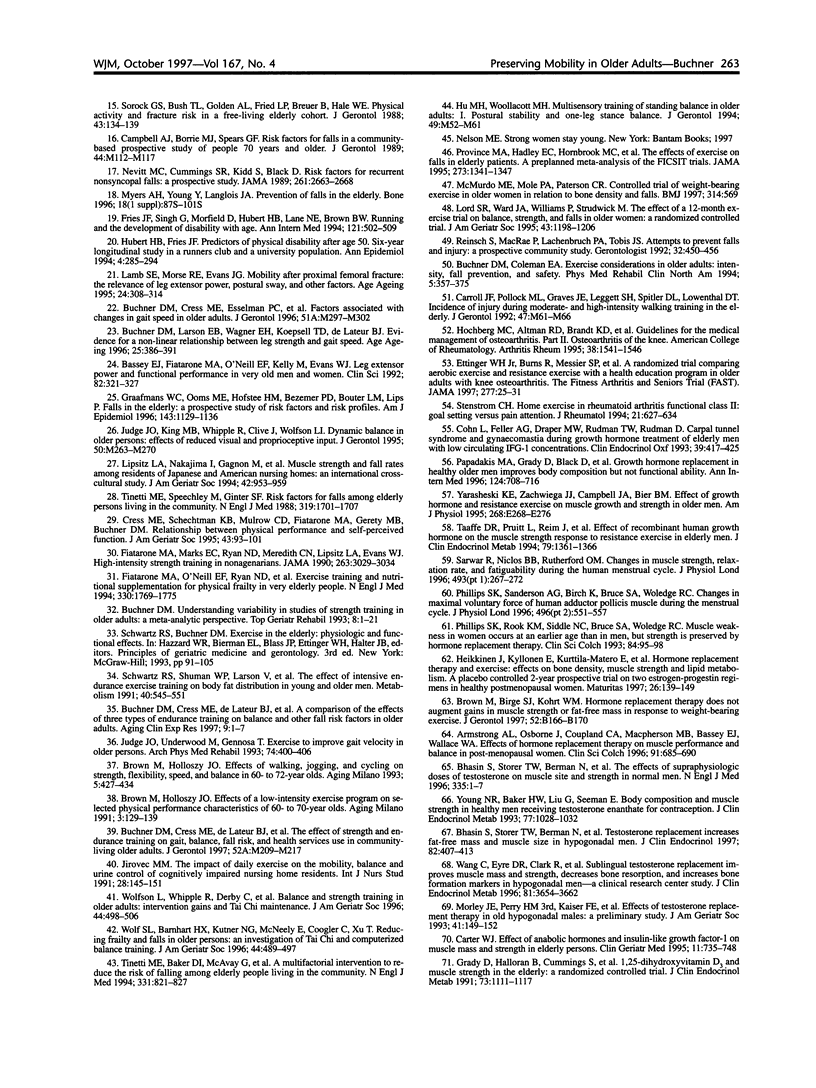
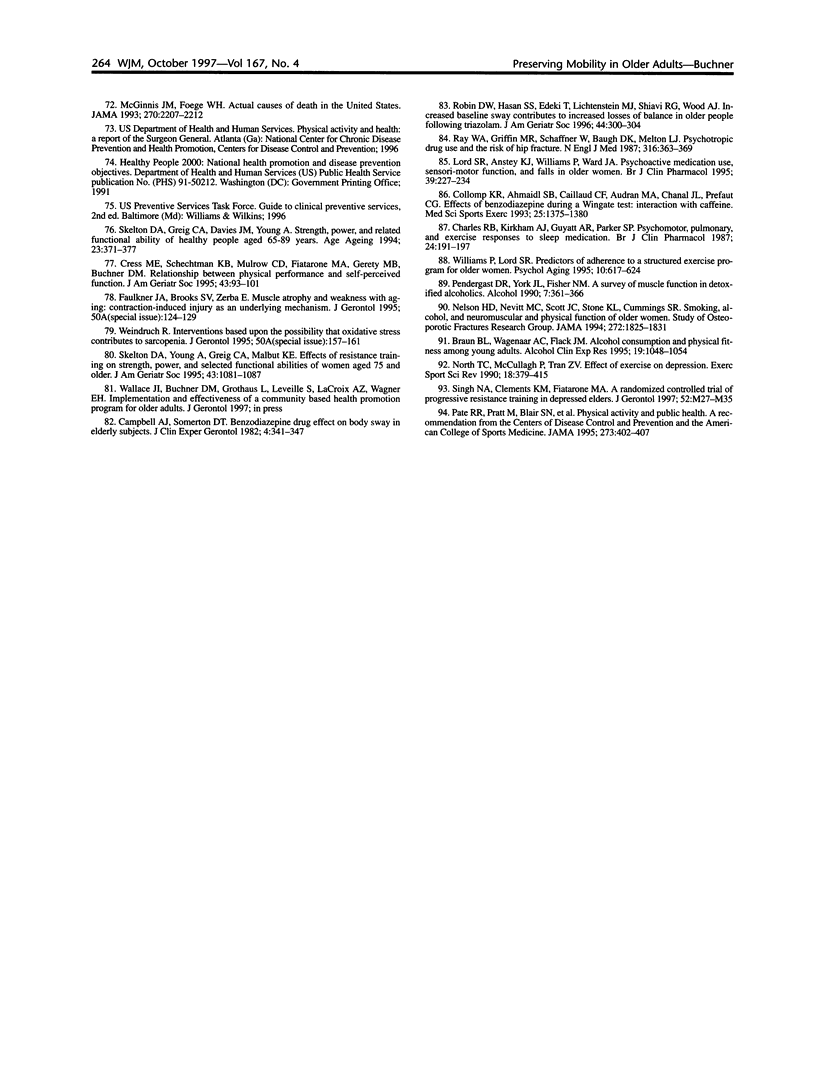
Selected References
These references are in PubMed. This may not be the complete list of references from this article.
- Armstrong A. L., Oborne J., Coupland C. A., Macpherson M. B., Bassey E. J., Wallace W. A. Effects of hormone replacement therapy on muscle performance and balance in post-menopausal women. Clin Sci (Lond) 1996 Dec;91(6):685–690. doi: 10.1042/cs0910685. [DOI] [PubMed] [Google Scholar]
- Bassey E. J., Fiatarone M. A., O'Neill E. F., Kelly M., Evans W. J., Lipsitz L. A. Leg extensor power and functional performance in very old men and women. Clin Sci (Lond) 1992 Mar;82(3):321–327. doi: 10.1042/cs0820321. [DOI] [PubMed] [Google Scholar]
- Bhasin S., Storer T. W., Berman N., Callegari C., Clevenger B., Phillips J., Bunnell T. J., Tricker R., Shirazi A., Casaburi R. The effects of supraphysiologic doses of testosterone on muscle size and strength in normal men. N Engl J Med. 1996 Jul 4;335(1):1–7. doi: 10.1056/NEJM199607043350101. [DOI] [PubMed] [Google Scholar]
- Bhasin S., Storer T. W., Berman N., Yarasheski K. E., Clevenger B., Phillips J., Lee W. P., Bunnell T. J., Casaburi R. Testosterone replacement increases fat-free mass and muscle size in hypogonadal men. J Clin Endocrinol Metab. 1997 Feb;82(2):407–413. doi: 10.1210/jcem.82.2.3733. [DOI] [PubMed] [Google Scholar]
- Braun B. L., Wagenaar A. C., Flack J. M. Alcohol consumption and physical fitness among young adults. Alcohol Clin Exp Res. 1995 Aug;19(4):1048–1054. doi: 10.1111/j.1530-0277.1995.tb00987.x. [DOI] [PubMed] [Google Scholar]
- Brown M., Birge S. J., Kohrt W. M. Hormone replacement therapy does not augment gains in muscle strength or fat-free mass in response to weight-bearing exercise. J Gerontol A Biol Sci Med Sci. 1997 May;52(3):B166–B170. doi: 10.1093/gerona/52a.3.b166. [DOI] [PubMed] [Google Scholar]
- Brown M., Holloszy J. O. Effects of a low intensity exercise program on selected physical performance characteristics of 60- to 71-year olds. Aging (Milano) 1991 Jun;3(2):129–139. doi: 10.1007/BF03323989. [DOI] [PubMed] [Google Scholar]
- Brown M., Holloszy J. O. Effects of walking, jogging and cycling on strength, flexibility, speed and balance in 60- to 72-year olds. Aging (Milano) 1993 Dec;5(6):427–434. doi: 10.1007/BF03324197. [DOI] [PubMed] [Google Scholar]
- Buchner D. M., Cress M. E., Esselman P. C., Margherita A. J., de Lateur B. J., Campbell A. J., Wagner E. H. Factors associated with changes in gait speed in older adults. J Gerontol A Biol Sci Med Sci. 1996 Nov;51(6):M297–M302. doi: 10.1093/gerona/51a.6.m297. [DOI] [PubMed] [Google Scholar]
- Buchner D. M., Larson E. B., Wagner E. H., Koepsell T. D., de Lateur B. J. Evidence for a non-linear relationship between leg strength and gait speed. Age Ageing. 1996 Sep;25(5):386–391. doi: 10.1093/ageing/25.5.386. [DOI] [PubMed] [Google Scholar]
- Campbell A. J., Borrie M. J., Spears G. F. Risk factors for falls in a community-based prospective study of people 70 years and older. J Gerontol. 1989 Jul;44(4):M112–M117. doi: 10.1093/geronj/44.4.m112. [DOI] [PubMed] [Google Scholar]
- Carroll J. F., Pollock M. L., Graves J. E., Leggett S. H., Spitler D. L., Lowenthal D. T. Incidence of injury during moderate- and high-intensity walking training in the elderly. J Gerontol. 1992 May;47(3):M61–M66. doi: 10.1093/geronj/47.3.m61. [DOI] [PubMed] [Google Scholar]
- Carter W. J. Effect of anabolic hormones and insulin-like growth factor-I on muscle mass and strength in elderly persons. Clin Geriatr Med. 1995 Nov;11(4):735–748. [PubMed] [Google Scholar]
- Charles R. B., Kirkham A. J., Guyatt A. R., Parker S. P. Psychomotor, pulmonary and exercise responses to sleep medication. Br J Clin Pharmacol. 1987 Aug;24(2):191–197. doi: 10.1111/j.1365-2125.1987.tb03161.x. [DOI] [PMC free article] [PubMed] [Google Scholar]
- Chesnut C. H., 3rd, Ivey J. L., Gruber H. E., Matthews M., Nelp W. B., Sisom K., Baylink D. J. Stanozolol in postmenopausal osteoporosis: therapeutic efficacy and possible mechanisms of action. Metabolism. 1983 Jun;32(6):571–580. doi: 10.1016/0026-0495(83)90027-6. [DOI] [PubMed] [Google Scholar]
- Cohn L., Feller A. G., Draper M. W., Rudman I. W., Rudman D. Carpal tunnel syndrome and gynaecomastia during growth hormone treatment of elderly men with low circulating IGF-I concentrations. Clin Endocrinol (Oxf) 1993 Oct;39(4):417–425. doi: 10.1111/j.1365-2265.1993.tb02388.x. [DOI] [PubMed] [Google Scholar]
- Collomp K. R., Ahmaidi S. B., Caillaud C. F., Audran M. A., Chanal J. L., Préfaut C. G. Effects of benzodiazepine during a Wingate test: interaction with caffeine. Med Sci Sports Exerc. 1993 Dec;25(12):1375–1380. [PubMed] [Google Scholar]
- Cress M. E., Schechtman K. B., Mulrow C. D., Fiatarone M. A., Gerety M. B., Buchner D. M. Relationship between physical performance and self-perceived physical function. J Am Geriatr Soc. 1995 Feb;43(2):93–101. doi: 10.1111/j.1532-5415.1995.tb06372.x. [DOI] [PubMed] [Google Scholar]
- Cress M. E., Schechtman K. B., Mulrow C. D., Fiatarone M. A., Gerety M. B., Buchner D. M. Relationship between physical performance and self-perceived physical function. J Am Geriatr Soc. 1995 Feb;43(2):93–101. doi: 10.1111/j.1532-5415.1995.tb06372.x. [DOI] [PubMed] [Google Scholar]
- Ettinger W. H., Jr, Burns R., Messier S. P., Applegate W., Rejeski W. J., Morgan T., Shumaker S., Berry M. J., O'Toole M., Monu J. A randomized trial comparing aerobic exercise and resistance exercise with a health education program in older adults with knee osteoarthritis. The Fitness Arthritis and Seniors Trial (FAST). JAMA. 1997 Jan 1;277(1):25–31. [PubMed] [Google Scholar]
- Faulkner J. A., Brooks S. V., Zerba E. Muscle atrophy and weakness with aging: contraction-induced injury as an underlying mechanism. J Gerontol A Biol Sci Med Sci. 1995 Nov;50(Spec No):124–129. doi: 10.1093/gerona/50a.special_issue.124. [DOI] [PubMed] [Google Scholar]
- Fiatarone M. A., Marks E. C., Ryan N. D., Meredith C. N., Lipsitz L. A., Evans W. J. High-intensity strength training in nonagenarians. Effects on skeletal muscle. JAMA. 1990 Jun 13;263(22):3029–3034. [PubMed] [Google Scholar]
- Fiatarone M. A., O'Neill E. F., Ryan N. D., Clements K. M., Solares G. R., Nelson M. E., Roberts S. B., Kehayias J. J., Lipsitz L. A., Evans W. J. Exercise training and nutritional supplementation for physical frailty in very elderly people. N Engl J Med. 1994 Jun 23;330(25):1769–1775. doi: 10.1056/NEJM199406233302501. [DOI] [PubMed] [Google Scholar]
- Fries J. F., Singh G., Morfeld D., Hubert H. B., Lane N. E., Brown B. W., Jr Running and the development of disability with age. Ann Intern Med. 1994 Oct 1;121(7):502–509. doi: 10.7326/0003-4819-121-7-199410010-00005. [DOI] [PubMed] [Google Scholar]
- Graafmans W. C., Ooms M. E., Hofstee H. M., Bezemer P. D., Bouter L. M., Lips P. Falls in the elderly: a prospective study of risk factors and risk profiles. Am J Epidemiol. 1996 Jun 1;143(11):1129–1136. doi: 10.1093/oxfordjournals.aje.a008690. [DOI] [PubMed] [Google Scholar]
- Grady D., Halloran B., Cummings S., Leveille S., Wells L., Black D., Byl N. 1,25-Dihydroxyvitamin D3 and muscle strength in the elderly: a randomized controlled trial. J Clin Endocrinol Metab. 1991 Nov;73(5):1111–1117. doi: 10.1210/jcem-73-5-1111. [DOI] [PubMed] [Google Scholar]
- Heikkinen J., Kyllönen E., Kurttila-Matero E., Wilén-Rosenqvist G., Lankinen K. S., Rita H., Vänänen H. K. HRT and exercise: effects on bone density, muscle strength and lipid metabolism. A placebo controlled 2-year prospective trial on two estrogen-progestin regimens in healthy postmenopausal women. Maturitas. 1997 Mar;26(2):139–149. doi: 10.1016/s0378-5122(96)01098-5. [DOI] [PubMed] [Google Scholar]
- Hochberg M. C., Altman R. D., Brandt K. D., Clark B. M., Dieppe P. A., Griffin M. R., Moskowitz R. W., Schnitzer T. J. Guidelines for the medical management of osteoarthritis. Part II. Osteoarthritis of the knee. American College of Rheumatology. Arthritis Rheum. 1995 Nov;38(11):1541–1546. doi: 10.1002/art.1780381104. [DOI] [PubMed] [Google Scholar]
- Hu M. H., Woollacott M. H. Multisensory training of standing balance in older adults: I. Postural stability and one-leg stance balance. J Gerontol. 1994 Mar;49(2):M52–M61. doi: 10.1093/geronj/49.2.m52. [DOI] [PubMed] [Google Scholar]
- Hubert H. B., Bloch D. A., Fries J. F. Risk factors for physical disability in an aging cohort: the NHANES I Epidemiologic Followup Study. J Rheumatol. 1993 Mar;20(3):480–488. [PubMed] [Google Scholar]
- Hubert H. B., Fries J. F. Predictors of physical disability after age 50. Six-year longitudinal study in a runners club and a university population. Ann Epidemiol. 1994 Jul;4(4):285–294. doi: 10.1016/1047-2797(94)90084-1. [DOI] [PubMed] [Google Scholar]
- Jirovec M. M. The impact of daily exercise on the mobility, balance and urine control of cognitively impaired nursing home residents. Int J Nurs Stud. 1991;28(2):145–151. doi: 10.1016/0020-7489(91)90004-m. [DOI] [PubMed] [Google Scholar]
- Judge J. O., King M. B., Whipple R., Clive J., Wolfson L. I. Dynamic balance in older persons: effects of reduced visual and proprioceptive input. J Gerontol A Biol Sci Med Sci. 1995 Sep;50(5):M263–M270. doi: 10.1093/gerona/50a.5.m263. [DOI] [PubMed] [Google Scholar]
- Judge J. O., Underwood M., Gennosa T. Exercise to improve gait velocity in older persons. Arch Phys Med Rehabil. 1993 Apr;74(4):400–406. [PubMed] [Google Scholar]
- Jónsson B., Ringsberg K., Josefsson P. O., Johnell O., Birch-Jensen M. Effects of physical activity on bone mineral content and muscle strength in women: a cross-sectional study. Bone. 1992;13(2):191–195. doi: 10.1016/8756-3282(92)90011-k. [DOI] [PubMed] [Google Scholar]
- LaCroix A. Z., Guralnik J. M., Berkman L. F., Wallace R. B., Satterfield S. Maintaining mobility in late life. II. Smoking, alcohol consumption, physical activity, and body mass index. Am J Epidemiol. 1993 Apr 15;137(8):858–869. doi: 10.1093/oxfordjournals.aje.a116747. [DOI] [PubMed] [Google Scholar]
- Lamb S. E., Morse R. E., Evans J. G. Mobility after proximal femoral fracture: the relevance of leg extensor power, postural sway and other factors. Age Ageing. 1995 Jul;24(4):308–314. doi: 10.1093/ageing/24.4.308. [DOI] [PubMed] [Google Scholar]
- Lipsitz L. A., Nakajima I., Gagnon M., Hirayama T., Connelly C. M., Izumo H., Hirayama T. Muscle strength and fall rates among residents of Japanese and American nursing homes: an International Cross-Cultural Study. J Am Geriatr Soc. 1994 Sep;42(9):953–959. doi: 10.1111/j.1532-5415.1994.tb06586.x. [DOI] [PubMed] [Google Scholar]
- Lord S. R., Anstey K. J., Williams P., Ward J. A. Psychoactive medication use, sensori-motor function and falls in older women. Br J Clin Pharmacol. 1995 Mar;39(3):227–234. doi: 10.1111/j.1365-2125.1995.tb04441.x. [DOI] [PMC free article] [PubMed] [Google Scholar]
- Lord S. R., Ward J. A., Williams P., Strudwick M. The effect of a 12-month exercise trial on balance, strength, and falls in older women: a randomized controlled trial. J Am Geriatr Soc. 1995 Nov;43(11):1198–1206. doi: 10.1111/j.1532-5415.1995.tb07394.x. [DOI] [PubMed] [Google Scholar]
- Lye M. D., Ritch A. E. A double-blind trial of an anabolic steroid (stanozolol) in the disabled elderly. Rheumatol Rehabil. 1977 Feb;16(1):62–69. doi: 10.1093/rheumatology/16.1.62. [DOI] [PubMed] [Google Scholar]
- McGinnis J. M., Foege W. H. Actual causes of death in the United States. JAMA. 1993 Nov 10;270(18):2207–2212. [PubMed] [Google Scholar]
- McMurdo M. E., Mole P. A., Paterson C. R. Controlled trial of weight bearing exercise in older women in relation to bone density and falls. BMJ. 1997 Feb 22;314(7080):569–569. doi: 10.1136/bmj.314.7080.569. [DOI] [PMC free article] [PubMed] [Google Scholar]
- Moritani T., deVries H. A. Potential for gross muscle hypertrophy in older men. J Gerontol. 1980 Sep;35(5):672–682. doi: 10.1093/geronj/35.5.672. [DOI] [PubMed] [Google Scholar]
- Morley J. E., Perry H. M., 3rd, Kaiser F. E., Kraenzle D., Jensen J., Houston K., Mattammal M., Perry H. M., Jr Effects of testosterone replacement therapy in old hypogonadal males: a preliminary study. J Am Geriatr Soc. 1993 Feb;41(2):149–152. doi: 10.1111/j.1532-5415.1993.tb02049.x. [DOI] [PubMed] [Google Scholar]
- Myers A. H., Young Y., Langlois J. A. Prevention of falls in the elderly. Bone. 1996 Jan;18(1 Suppl):87S–101S. doi: 10.1016/8756-3282(95)00384-3. [DOI] [PubMed] [Google Scholar]
- Nelson H. D., Nevitt M. C., Scott J. C., Stone K. L., Cummings S. R. Smoking, alcohol, and neuromuscular and physical function of older women. Study of Osteoporotic Fractures Research Group. JAMA. 1994 Dec 21;272(23):1825–1831. doi: 10.1001/jama.1994.03520230035035. [DOI] [PubMed] [Google Scholar]
- Nevitt M. C., Cummings S. R., Kidd S., Black D. Risk factors for recurrent nonsyncopal falls. A prospective study. JAMA. 1989 May 12;261(18):2663–2668. [PubMed] [Google Scholar]
- North T. C., McCullagh P., Tran Z. V. Effect of exercise on depression. Exerc Sport Sci Rev. 1990;18:379–415. [PubMed] [Google Scholar]
- PERKINS L. C., KAISER H. L. Results of short term isotonic and isometric exercise programs in persons over sixty. Phys Ther Rev. 1961 Sep;41:633–635. doi: 10.1093/ptj/41.9.633. [DOI] [PubMed] [Google Scholar]
- Papadakis M. A., Grady D., Black D., Tierney M. J., Gooding G. A., Schambelan M., Grunfeld C. Growth hormone replacement in healthy older men improves body composition but not functional ability. Ann Intern Med. 1996 Apr 15;124(8):708–716. doi: 10.7326/0003-4819-124-8-199604150-00002. [DOI] [PubMed] [Google Scholar]
- Pate R. R., Pratt M., Blair S. N., Haskell W. L., Macera C. A., Bouchard C., Buchner D., Ettinger W., Heath G. W., King A. C. Physical activity and public health. A recommendation from the Centers for Disease Control and Prevention and the American College of Sports Medicine. JAMA. 1995 Feb 1;273(5):402–407. doi: 10.1001/jama.273.5.402. [DOI] [PubMed] [Google Scholar]
- Pendergast D. R., York J. L., Fisher N. M. A survey of muscle function in detoxified alcoholics. Alcohol. 1990 Jul-Aug;7(4):361–366. doi: 10.1016/0741-8329(90)90096-u. [DOI] [PubMed] [Google Scholar]
- Phillips S. K., Rook K. M., Siddle N. C., Bruce S. A., Woledge R. C. Muscle weakness in women occurs at an earlier age than in men, but strength is preserved by hormone replacement therapy. Clin Sci (Lond) 1993 Jan;84(1):95–98. doi: 10.1042/cs0840095. [DOI] [PubMed] [Google Scholar]
- Phillips S. K., Sanderson A. G., Birch K., Bruce S. A., Woledge R. C. Changes in maximal voluntary force of human adductor pollicis muscle during the menstrual cycle. J Physiol. 1996 Oct 15;496(Pt 2):551–557. doi: 10.1113/jphysiol.1996.sp021706. [DOI] [PMC free article] [PubMed] [Google Scholar]
- Province M. A., Hadley E. C., Hornbrook M. C., Lipsitz L. A., Miller J. P., Mulrow C. D., Ory M. G., Sattin R. W., Tinetti M. E., Wolf S. L. The effects of exercise on falls in elderly patients. A preplanned meta-analysis of the FICSIT Trials. Frailty and Injuries: Cooperative Studies of Intervention Techniques. JAMA. 1995 May 3;273(17):1341–1347. [PubMed] [Google Scholar]
- Ray W. A., Griffin M. R., Schaffner W., Baugh D. K., Melton L. J., 3rd Psychotropic drug use and the risk of hip fracture. N Engl J Med. 1987 Feb 12;316(7):363–369. doi: 10.1056/NEJM198702123160702. [DOI] [PubMed] [Google Scholar]
- Reinsch S., MacRae P., Lachenbruch P. A., Tobis J. S. Attempts to prevent falls and injury: a prospective community study. Gerontologist. 1992 Aug;32(4):450–456. doi: 10.1093/geront/32.4.450. [DOI] [PubMed] [Google Scholar]
- Robin D. W., Hasan S. S., Edeki T., Lichtenstein M. J., Shiavi R. G., Wood A. J. Increased baseline sway contributes to increased losses of balance in older people following triazolam. J Am Geriatr Soc. 1996 Mar;44(3):300–304. doi: 10.1111/j.1532-5415.1996.tb00919.x. [DOI] [PubMed] [Google Scholar]
- Rudman D., Feller A. G., Nagraj H. S., Gergans G. A., Lalitha P. Y., Goldberg A. F., Schlenker R. A., Cohn L., Rudman I. W., Mattson D. E. Effects of human growth hormone in men over 60 years old. N Engl J Med. 1990 Jul 5;323(1):1–6. doi: 10.1056/NEJM199007053230101. [DOI] [PubMed] [Google Scholar]
- Sandler R. B., Burdett R., Zaleskiewicz M., Sprowls-Repcheck C., Harwell M. Muscle strength as an indicator of the habitual level of physical activity. Med Sci Sports Exerc. 1991 Dec;23(12):1375–1381. [PubMed] [Google Scholar]
- Sarwar R., Niclos B. B., Rutherford O. M. Changes in muscle strength, relaxation rate and fatiguability during the human menstrual cycle. J Physiol. 1996 May 15;493(Pt 1):267–272. doi: 10.1113/jphysiol.1996.sp021381. [DOI] [PMC free article] [PubMed] [Google Scholar]
- Schwartz R. S., Shuman W. P., Larson V., Cain K. C., Fellingham G. W., Beard J. C., Kahn S. E., Stratton J. R., Cerqueira M. D., Abrass I. B. The effect of intensive endurance exercise training on body fat distribution in young and older men. Metabolism. 1991 May;40(5):545–551. doi: 10.1016/0026-0495(91)90239-s. [DOI] [PubMed] [Google Scholar]
- Singh N. A., Clements K. M., Fiatarone M. A. A randomized controlled trial of progressive resistance training in depressed elders. J Gerontol A Biol Sci Med Sci. 1997 Jan;52(1):M27–M35. doi: 10.1093/gerona/52a.1.m27. [DOI] [PubMed] [Google Scholar]
- Skelton D. A., Greig C. A., Davies J. M., Young A. Strength, power and related functional ability of healthy people aged 65-89 years. Age Ageing. 1994 Sep;23(5):371–377. doi: 10.1093/ageing/23.5.371. [DOI] [PubMed] [Google Scholar]
- Skelton D. A., Young A., Greig C. A., Malbut K. E. Effects of resistance training on strength, power, and selected functional abilities of women aged 75 and older. J Am Geriatr Soc. 1995 Oct;43(10):1081–1087. doi: 10.1111/j.1532-5415.1995.tb07004.x. [DOI] [PubMed] [Google Scholar]
- Stenström C. H. Home exercise in rheumatoid arthritis functional class II: goal setting versus pain attention. J Rheumatol. 1994 Apr;21(4):627–634. [PubMed] [Google Scholar]
- Taaffe D. R., Pruitt L., Reim J., Hintz R. L., Butterfield G., Hoffman A. R., Marcus R. Effect of recombinant human growth hormone on the muscle strength response to resistance exercise in elderly men. J Clin Endocrinol Metab. 1994 Nov;79(5):1361–1366. doi: 10.1210/jcem.79.5.7525633. [DOI] [PubMed] [Google Scholar]
- Tamai M., Kubota M., Ikeda M., Nagao K., Irikura N., Sugiyama M., Yoshikawa H., Kawamori R., Kamada T. Usefulness of anaerobic threshold for evaluating daily life activity and prescribing exercise to the healthy subjects and patients. J Med Syst. 1993 Aug;17(3-4):219–225. doi: 10.1007/BF00996949. [DOI] [PubMed] [Google Scholar]
- Tinetti M. E., Baker D. I., McAvay G., Claus E. B., Garrett P., Gottschalk M., Koch M. L., Trainor K., Horwitz R. I. A multifactorial intervention to reduce the risk of falling among elderly people living in the community. N Engl J Med. 1994 Sep 29;331(13):821–827. doi: 10.1056/NEJM199409293311301. [DOI] [PubMed] [Google Scholar]
- Tinetti M. E., Speechley M., Ginter S. F. Risk factors for falls among elderly persons living in the community. N Engl J Med. 1988 Dec 29;319(26):1701–1707. doi: 10.1056/NEJM198812293192604. [DOI] [PubMed] [Google Scholar]
- Wagner E. H., LaCroix A. Z., Buchner D. M., Larson E. B. Effects of physical activity on health status in older adults. I: Observational studies. Annu Rev Public Health. 1992;13:451–468. doi: 10.1146/annurev.pu.13.050192.002315. [DOI] [PubMed] [Google Scholar]
- Wang C., Eyre D. R., Clark R., Kleinberg D., Newman C., Iranmanesh A., Veldhuis J., Dudley R. E., Berman N., Davidson T. Sublingual testosterone replacement improves muscle mass and strength, decreases bone resorption, and increases bone formation markers in hypogonadal men--a clinical research center study. J Clin Endocrinol Metab. 1996 Oct;81(10):3654–3662. doi: 10.1210/jcem.81.10.8855818. [DOI] [PubMed] [Google Scholar]
- Weindruch R. Interventions based on the possibility that oxidative stress contributes to sarcopenia. J Gerontol A Biol Sci Med Sci. 1995 Nov;50(Spec No):157–161. doi: 10.1093/gerona/50a.special_issue.157. [DOI] [PubMed] [Google Scholar]
- Williams P., Lord S. R. Predictors of adherence to a structured exercise program for older women. Psychol Aging. 1995 Dec;10(4):617–624. doi: 10.1037//0882-7974.10.4.617. [DOI] [PubMed] [Google Scholar]
- Wolf S. L., Barnhart H. X., Kutner N. G., McNeely E., Coogler C., Xu T. Reducing frailty and falls in older persons: an investigation of Tai Chi and computerized balance training. Atlanta FICSIT Group. Frailty and Injuries: Cooperative Studies of Intervention Techniques. J Am Geriatr Soc. 1996 May;44(5):489–497. doi: 10.1111/j.1532-5415.1996.tb01432.x. [DOI] [PubMed] [Google Scholar]
- Wolfson L., Whipple R., Derby C., Judge J., King M., Amerman P., Schmidt J., Smyers D. Balance and strength training in older adults: intervention gains and Tai Chi maintenance. J Am Geriatr Soc. 1996 May;44(5):498–506. doi: 10.1111/j.1532-5415.1996.tb01433.x. [DOI] [PubMed] [Google Scholar]
- Yarasheski K. E., Zachwieja J. J., Campbell J. A., Bier D. M. Effect of growth hormone and resistance exercise on muscle growth and strength in older men. Am J Physiol. 1995 Feb;268(2 Pt 1):E268–E276. doi: 10.1152/ajpendo.1995.268.2.E268. [DOI] [PubMed] [Google Scholar]
- Young N. R., Baker H. W., Liu G., Seeman E. Body composition and muscle strength in healthy men receiving testosterone enanthate for contraception. J Clin Endocrinol Metab. 1993 Oct;77(4):1028–1032. doi: 10.1210/jcem.77.4.8408450. [DOI] [PubMed] [Google Scholar]


